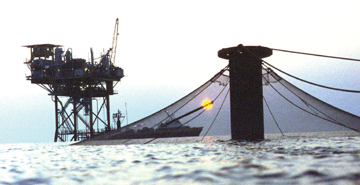 In its
hefty report on the state of the oceans and federal ocean policies, the U.S.
Commission on Ocean Policy suggested setting a course for using the oceans to
farm fish, not just catch them. The Bush administration seized upon this notion,
calling for a sustainable plan to increase mariculture — offshore marine
fish farming. One option is to use the thousands of oil and natural gas platforms
that line the nation’s coasts as staging areas for the farms. Although
fish farming in federal waters is not yet a commercial reality, many in industry
and government are forging ahead with mariculture plans.
In its
hefty report on the state of the oceans and federal ocean policies, the U.S.
Commission on Ocean Policy suggested setting a course for using the oceans to
farm fish, not just catch them. The Bush administration seized upon this notion,
calling for a sustainable plan to increase mariculture — offshore marine
fish farming. One option is to use the thousands of oil and natural gas platforms
that line the nation’s coasts as staging areas for the farms. Although
fish farming in federal waters is not yet a commercial reality, many in industry
and government are forging ahead with mariculture plans.Net pens (in the foreground) established around oil platforms, such as this one in the Gulf of Mexico, can hold up to 150,000 pounds of fish. New energy is being put into the effort to convert oil and natural gas platforms into staging areas for fish farming. Courtesy of NOAA.
A primary driver for the push toward mariculture is increased consumption of fish in the United States, says Michael Rubino, aquaculture program manager for the National Oceanic and Atmospheric Administration (NOAA). “We already import close to 70 percent of our seafood,” he says, with U.S. imports accounting for $7 billion annually in trade deficits, a number that is projected to rise.
“We’ve already wiped out the major stocks of big fish in the ocean and are beginning to deplete the smaller-sized stocks as well,” says Paul Sammarco with the Louisiana Universities Marine Consortium, which conducts marine research and education activities in Louisiana. Other countries, such as Japan, are building platforms offshore specifically for mariculture, he says. The United States already has the highest density of offshore platforms, which are much more substantial in structure and of much higher value, he says, “so why not put them to new use?”
The majority of U.S. offshore oil and gas platforms are in the Gulf of Mexico, where 3,600 platforms are scattered up to several hundred miles offshore. Most of the platforms are currently active. Under current legislation, once a company stops producing oil or gas from a platform, they have about a year to decommission and remove it, Sammarco says. It costs oil companies anywhere from $2 million to $30 million to decommission and remove platforms, says Granvil Treece with NOAA’s Sea Grant program in Texas, depending on a platform’s size and distance from shore. It would cost significantly less, he says, to leave the platforms in place even if they are decommissioned.
Removing the platforms would also represent a loss of reef communities that have developed on and around these artificial reefs, Sammarco says. The Gulf of Mexico alone contains 3,600 thriving platform reef systems. “By volume, these are the most productive ecosystems on the planet.” Turning the platforms into home bases for fishing would save the oil companies money, while preserving the ecosystems, Sammarco says.
Like offshore oil workers, fish farmers could sleep on the platforms, and food and equipment for the fish farms could be stored onboard, says James McVey, aquaculture program manager for the National Sea Grant College Program. The platforms also could be used as hatcheries, he says. The average-sized platform could support at least four 3,000-cubic-meter net pens, which can each contain 100,000 to 150,000 pounds of fish.
Mariculture is already a reality in state waters, where permitting processes are in place, McVey says. Fish are commercially grown in Hawaii, Puerto Rico and New Hampshire, for example — though not using oil platforms as bases. Where fish are currently farmed, scientists have been studying environmental impacts, including monitoring the waters above, below and 100 meters away from a net, and checking the sediments on the seafloor below for fecal contaminants and nutrient levels. Their research has shown that as long as fish farms are sited properly, contaminants do not cause significant environmental change.
But environmental groups have concerns about the long-term effects of large-scale mariculture. With regard to oil-platform use, for example, Catherine Hazlewood of The Ocean Conservancy points to pollutants such as barite that are associated with oil rigs. She says that unless the oil companies are required to decommission the rigs as current law dictates, these toxins will remain in the water. Current legislative proposals do not force the oil companies to decommission the platforms or restore the surrounding ecosystems, they simply release liability for the oil company and transfer ownership to a new owner or user. Other concerns relate to mariculture as a whole, such as the possibility of disease or parasites spreading from farmed fish to natural fish.
But McVey says that “we have enough information to provide best management practices for mariculture.” Additionally, the National Marine Fisheries Service has already developed a code of conduct for responsible fish farming, as has the U.N. Food and Agriculture Organization.
NOAA is working on a bill to set up a regulatory process to allow mariculture options to move forward, Rubino says. The president hopes to send a mariculture bill to Congress sometime this year.
Megan Sever
Links:
NOAA Fisheries
NOAA Sea Grant
Rigs-to-Reef
Committee on Ocean Policy
The Ocean Conservancy
Back to top

